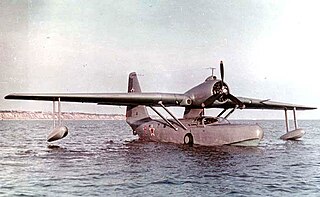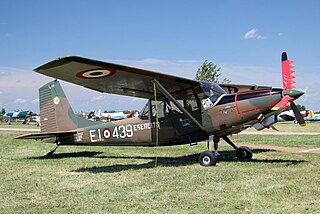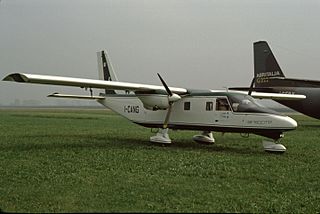The FF-1080 is an aircraft design by Utilicraft Aerospace Industries of Albuquerque, New Mexico, USA, for a twin turboprop aircraft fitted to carry LD3 aircraft cargo containers between large airports and smaller airports.

The Convair R3Y Tradewind was an American 1950s turboprop-powered flying boat designed and built by Convair.

The Shin Meiwa PS-1 and US-1A is a large STOL aircraft designed for anti-submarine warfare (ASW) and air-sea rescue (SAR) work respectively by Japanese aircraft manufacturer Shin Meiwa. The PS-1 anti-submarine warfare (ASW) variant is a flying boat which carried its own beaching gear on board, while the search-and-rescue (SAR) orientated US-1A is a true amphibian.

The Douglas A2D Skyshark was an American turboprop-powered attack aircraft built by the Douglas Aircraft Company for the United States Navy. The program was substantially delayed by engine reliability problems, and was canceled because more promising jet attack aircraft had entered development and the smaller escort carriers the A2D was intended to utilize were being phased out.

The Beriev Be-12 Chayka is a Soviet turboprop-powered amphibious aircraft designed in the 1950s for anti-submarine and maritime patrol duties.

The Cessna 441 Conquest II is the first turboprop powered aircraft designed by Cessna and was meant to fill the gap between their jets and piston-engined aircraft. It was developed in November 1974, with the first aircraft delivered in September 1977. It is a pressurized, 8–9 passenger turbine development of the Cessna 404 Titan. The ICAO designator as used in flight plans is C441.

The Canadair CL-66 was a turboprop version of the civilian Convair CV-440 Metropolitan. The CC-109 Cosmopolitan or "Cosmo" in RCAF service became the standard VIP aircraft as well as replacing the Douglas Dakota and the North American B-25 Mitchell in light transport duties. After a lengthy career stretching into the 1990s, the CC-109 was replaced by the CC-142 Dash 8 and CC-144 Challenger.

The Beriev Be-6 was a flying boat produced by the Soviet Beriev OKB. It was capable of accomplishing a wide variety of missions, such as long-range maritime reconnaissance, coastal and supply line patrols, torpedo/bombing strikes, mine-laying, and transport operations.

The Beriev Be-8, was built by the Soviet Beriev OKB in 1947. It was a passenger/liaison amphibian aircraft with a layout similar to the Be-4 but substantially larger and heavier. It was a single engined parasol winged aircraft, with the wing installed on a thin pylon and two pairs of short struts. Compared to the Be-4, the Be-8 was equipped with retractable landing gear, with cockpit and passenger cabins heated by an engine exhaust heat exchanger. The Be-8 was intended as a civil aircraft and carried no armament. First flight was on 3 December 1947, demonstrating good performance and of the two prototypes, one was demonstrated during the 1951 Soviet Aviation Day at Tushino.

The Beriev Be-103 is an amphibious seaplane designed by Beriev and constructed by the Komsomolsk-on-Amur Aircraft Production Association (KnAAPO) in Russia. Intended for autonomous operation in the unmarked areas of Russia's far north and Siberia, the Be-103 was designed for short-haul routes in regions that have rivers, lakes and streams, but are otherwise inaccessible.

The Cessna 425, known as the Corsair and later as the Conquest I, is an eight-seat American pressurized turboprop twin-engined light aircraft. Now out of production, it was built by Cessna Aircraft of Wichita, Kansas, between 1980 and 1986.

The Beriev Be-30 is a Russian regional airliner and utility transport aircraft designed by the Beriev Design Bureau. It was developed specifically for Aeroflot local service routes using short, grass airstrips. It was also designed to be used in the light transport, aerial survey and air ambulance roles. It competed against the Antonov An-28 and the Czechoslovakian LET-410.

The Saunders ST-27 was a regional aircraft built in the 1970s by the Canadian Saunders Aircraft Company based at Gimli, Manitoba. The aircraft was designed as a conversion of the earlier de Havilland Heron. The conversion program was extensive and featured two Pratt & Whitney Canada PT6 turboprops and a stretched fuselage. Despite its promise as a regional airliner, the project collapsed when Manitoba government funding was withdrawn in 1976.

The Harbin SH-5 is a Chinese maritime patrol amphibious aircraft intended for a wide range of duties, including aerial firefighting, anti-submarine warfare (ASW) and air-sea rescue (ASR). One prototype and six production aircraft have been built.

The Piaggio P.166 is an Italian twin-engine pusher-type utility aircraft developed by Piaggio Aero. The aircraft model name was Portofino, and is also known as Albatross in South African military service.

The AS/SA 202 Bravo is a two to three-seat civil light aircraft jointly designed and manufactured by the Swiss company Flug- und Fahrzeugwerke Altenrhein (FFA) and the Italian company Savoia-Marchetti. The aircraft was designated the AS 202 in Switzerland, and the SA 202 in Italy.

The Colonial Model C-1 Skimmer was an American small single-engined amphibian flying boat built by the Colonial Aircraft Corporation. It was the start of a line of very similar aircraft designed by David Thurston.

The SIAI-Marchetti SM.1019 is an Italian STOL liaison monoplane built by SIAI-Marchetti for the Italian Army. It is a turboprop-powered derivative of the Cessna O-1 Bird Dog.

The Vulcanair SF.600 Canguro was a feederliner developed in Italy in the late 1970s. Despite a number of attempts to put the aircraft into series production, only a small number were ever built.

The MSW Votec 322 is a Swiss two-seat low-wing monoplane based on the Rihn DR-107 One Design and designed for amateur construction by MSW Aviation of Wohlen.



















